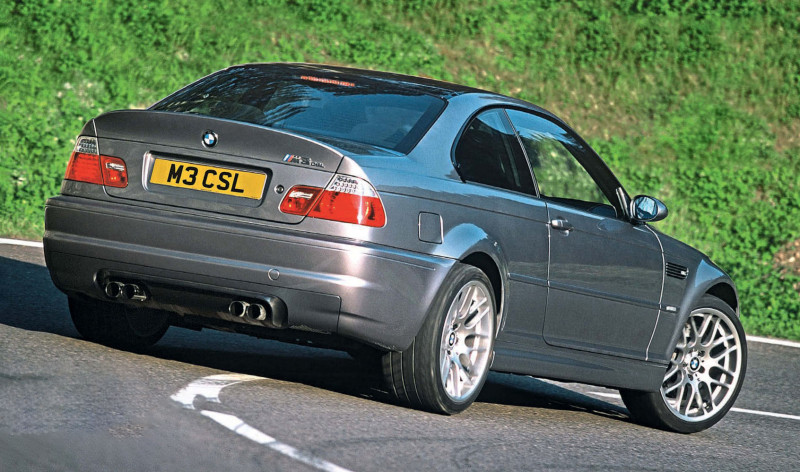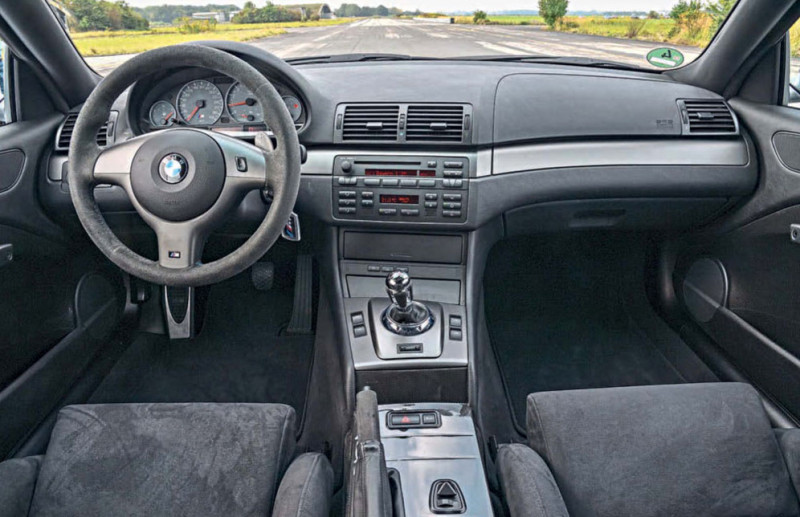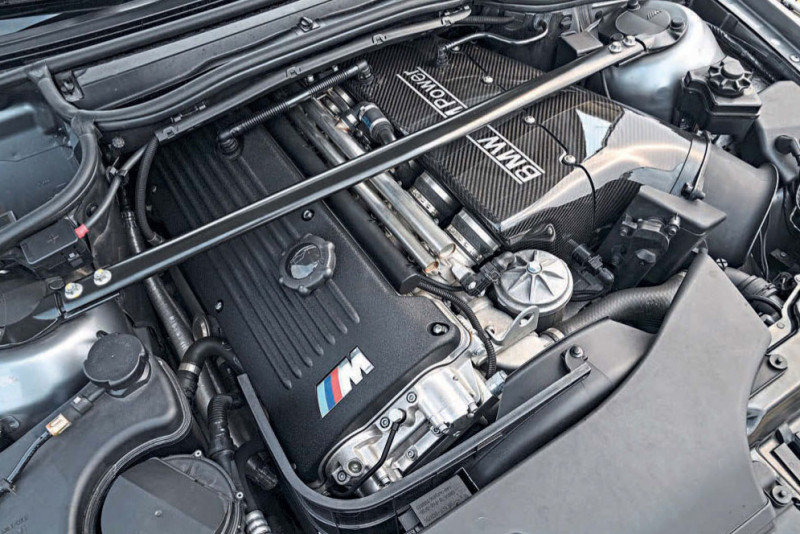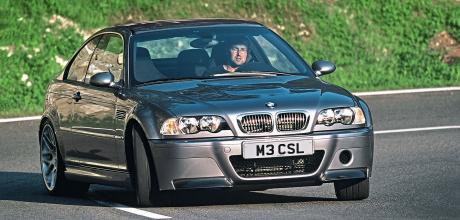2003 BMW M3 CSL E46/2S EU-spec
The second machine to wear the iconic Coupé, Sport, Lightweight moniker was the E46/2S M3, but was it as good as its wonderful namesake?
Words: Bob Harper
Photos: BMW
Second Time Around
Few modern M cars are as desirable as the mightyBMW E46/2S M3 CSL. We take a look back
You never forget your first drive in an M3 CSL. It’s a raw, visceral encounter, the M3 experience turned up to 11 and distilled into one of the finest rides to ever emerge from BMW M’s hallowed stables. The staccato bark from its sublime straight-six leaves an indelible mark on your psyche while the CSL’s deft chassis constantly eggs you on to try that little bit harder, rewarding you with a pure unadulterated driving experience. It’s not perfect by any means, but on the right piece of sinuous tarmac and in the right conditions, the E46 M3 CSL comes awfully close to motoring Nirvana.

The CSL owes much of its greatness to the already excellent E46/2S M3, but a series of tweaks by BMW M turned the regular M3 into what it was keen to term its ‘110% car’. Early press drives in prototype CSLs took place in 2002 before the production version was launched in 2003, complete with a price tag of £58,599 in the UK, a significant price hike over the standard M3.
So what did you get for your money? As the CSL moniker – Coup., Sport, Lightweight – would suggest, this new M3 model would major on weight loss, and this was apparent with its exterior, interior, mechanical make-up and its standard equipment list. Externally the big news was a carbon fibre roof, which not only saved a couple of kilos but also lowered the car’s centre of gravity. These days just about every M car comes with a carbon roof, but it was the CSL that started the trend, and thanks to its smallscale production, it allowed BMW to see if it could actually make the roof work properly.

Elsewhere there was a carbon fibre rear diffuser and carbon fibre flippers on the redesigned front bumper (mounted with lighter fixings), while the shapely ducktail boot lid was made from SMC (sheet moulding compound), and the boot floor is fashioned from aerospace-style alloy honeycomb. The doors were made of aluminium, as was the bonnet and even the rear window glass was thinner than in the standard machine. The distinctive 19” alloys weighed 11kg less than the regular 19s and came wrapped in super-sticky Michelin Pilot Sport Cup tyres, ideal for the track, though a bit tricky in the wet. Normal rubber could be added as a no-cost option though it did blunt the car’s ultimate ability. For UK buyers, specifying the Cup tyres compromised the CSL’s usability on Britain’s frequently cold, wet roads, and BMW would ask you to sign a disclaimer that you would ‘confirm that you are aware of and understand their unique performance characteristics’ of the tyres.
On the inside, there were carbon fibre door panels and racing seats with fixed backrests and a spartan covering of Alcantara, all in an effort to shave yet more weight off the car. Nice touches included an Alcantara-trimmed steering wheel, handbrake lever and inserts on the stubby SMG gear lever. Standard equipment was minimal, with air conditioning and radio being conspicuous by their absence, although they could be added as no-cost options.

Additionally, if you wanted a few more creature comforts, you could pay extra for xenon headlights, PDC, floor mats, a rain sensor for the wipers, and either a single CD player or a MiniDisc unit. The result of these weight-saving measures was a kerb weight of 1385kg, a saving of 110kg over the standard spec German model, impressive enough on its own, but the CSL added extra power and noise to the package, too.
The engine itself underwent several changes, including a minimal increase in the compression ratio, but the most obvious alteration under the bonnet was the redesigned air intake. A carbon fibre air box sucks air straight into the engine, which, as well as resulting in more power, meant one of the most sensational induction notes of just about any road car. The engine also featured larger diameter inlet manifolds, re-profiled camshafts, which were more extreme in profile with longer duration, and modified exhaust valves. The exhaust itself was made from thinner material to help save yet more weight. The end result was 360hp and 273lb ft of torque, which helped drop the 0-62 time by 0.3 seconds to 4.9. Top speed was limited to 155mph, but those drivers with a race licence could have their CSL derestricted.
While the engine’s enhanced performance was most welcome, it was the CSL’s chassis revisions that really allowed the driver to make the best use of the additional power. It gained revised spring and damper rates, with shorter front springs and modified compression and rebound strokes. The track was widened by 10mm at the front, and to take advantage of the car’s increased levels of grip and handling, the CSL was also fitted with a quicker steering rack with a 14.5:1 ratio versus the 15.4:1 of the standard M3.
While these changes weren’t earth-shattering, they were certainly enough to elevate the CSL to a higher plateau than the standard car, and in combination with the Cup tyres, really made it into something special. There were gripes about the standard spec, though, especially when it came to the braking department. Nestling behind the wheels were larger discs all-round, 345mm in diameter at the front and 328mm at the rear. BMW claimed this helped bring the 62-0mph time down to just 2.5 seconds, but the singlepiston calipers weren’t really up to the job, and many road testers found that the brakes wilted on track or even under prolonged use on the road.
The second major bugbear was the car’s transmission, with the Sequential Manual Gearbox II (SMG) being the only option. Yes, it had bespoke software and was brilliant when you were really on it, but it was less delightful when you used auto mode and ultimately robbed the driver of that further level of interaction that would have come with a six-speed manual ’box. No matter, the CSL did sell, despite its £58,599 price tag, although some cars did hang around in showrooms for an awfully long time and eventually were quite highly discounted. In the end, the CSL was manufactured for a brief eight-month period from May to December 2003, and in total, just 1383 were made, with 841 of those being left-hookers and 542 being right-hand drive. Just two colours were available – Silver grey and Black Sapphire.
Park a CSL up next to a standard E46/2S M3, and the cars are obviously closely related, but where the regular car looks handsome and brawny, the CSL somehow looks smaller, more purposeful and more overtly muscular. Its lower ride height, carbon roof, more aggressive front end and ducktail rear spoiler give it even better proportions than the normal M3, and the overall effect is simply jaw-dropping. It might be closely related to millions of other 3 Series models, but it manages to look every inch the supercar. Open the door, and you climb into body-hugging race seats rather than electric leather armchairs. Grip the fat, paddleequipped Alcantara steering wheel and absorb the carbonclad cabin, and the effect is a machine that does very little to conceal its intentions. Turn the key, and the Motorsport six explodes into life. Revved at a standstill, it sounds fantastic, but as soon as the engine is under load, it morphs into a bass-heavy bellow. This sounds like an angry car that demands you drive it hard. And in order to do that, you ideally wanted a CSL fitted with the Cup tyres and for the weather to be warm and dry. Get those three ducks in order, and you have a recipe for the perfect drive. On open, wellsurfaced roads, the CSL tracks round on perfect asphalt like a slot car. The cornering stance is utterly flat, with no trace of understeer on entry and pure traction on the exit. It feels as if all the slack has been trimmed out of the driving experience – not that the standard M3 is a woolly steer, but that’s how sharp the new machine is. Think about turning in, and the CSL has already nailed the apex. It is disconcertingly direct to begin with, until you recalibrate your brain to cope with the instant turn-in and massive grip.
It’s an intense experience, the gear changes coming thick and fast, the steering wheel alive with information from the chassis as every lump and camber change is transmitted to the driver. Normal tyres undermine the car’s ultimate performance, but a CSL on Cups during a typical British winter isn’t much fun – both ends will move around, with the front scrubbing wide with ambitious entry speeds, and the rear kicking out with injudicious use of the throttle. It’s never less than exhilarating, but the importance of being equipped with the right rubber has never been more important.
Spend a decent amount of time behind the wheel, and you’ll marvel at the noise, the speed of cog changes at maximum attack – just 0.08 seconds – and its poise, but you’ll also become aware of some downsides. That gearbox that’s great when you’re pushing on can be a little obstructive to smooth progress when not clipping apices, and in maximum-attack mode, the thump that accompanies each cog shift can become wearing for some drivers and their passengers. Some might revel in its sheer brutality, but even the most diehard CSL fan would probably tell you the ’box isn’t perfect.
While the E46’s driving position is generally excellent, the CSL’s bucket seats are pretty uncompromising. They are great for holding you in place when on a charge, but their padding is thin, and on a lumpy road, you can almost feel every imperfection through the seat of your pants. With no adjustment to the backrest, they are lacking in lumbar support, too, and after a while, you end up with the feeling that you’ve somehow been folded into a particular shape by the seat. A lack of armrests also becomes tiring when on the motorway or on a cruise. It’s also worth considering that when the CSL was new, its price was astronomical – we might be gradually getting used to M3s that now cost £80k, but back when the CSL was launched, it was a whopping 50% more than the standard M3. Back in 2003, you could have bought a normal M3, a MINI Cooper S and a damn good holiday for the same money. Perhaps that doesn’t matter anymore as the CSL is now a cult hero, and if you’d bought one when it was new and just parked it in the garage, you could probably sell it tomorrow for what, £200k, £300k? A lefthooker with less than 5000km on its odometer just sold at RM Sotheby’s for €325,000…
Despite a few minor gripes, the CSL should still go down in the history books as one of BMW M’s finest hours. You can’t help but come back to the noise – the induction roar is incredible – and it’s hard to believe that mere air being swallowed by the air box can make such an astonishing and spine-tingling sound. The engine is glorious with a razorsharp throttle response… did we mention the noise? From a rock-hard staccato at 3500rpm to a full-blooded scream at the redline, it’s still one of the best-sounding engines you’re ever likely to encounter on a road car and to squeeze those throttles wide open is a spell-binding experience. That it looks stunning and has a deliciously tactile chassis is the icing on the cake.
Carbon front flippers; CSL badging is subtle but made sure you knew this was something special.
You never forget your first drive in an E46 M3 CSL. It’s a raw, visceral encounter, the M3 experience turned up to 11 and distilled into one of the finest rides to ever emerge from BMW M’s hallowed stables
Revised S54 made 360hp, while the carbon air box generated the most incredible induction noise The CSL’s cabin is suitably spartan and short on creature comforts, but it was all about keeping weight down.
TECHNICAL DATA2003 BMW M3 CSL E46/2S UK-spec
- ENGINE: 3.2-litre straight-six S54B32
- TRANSMISSION: Sequential Manual Gearbox II SMG
- MAX POWER: 360hp @ 7900rpm
- MAX TORQUE: 273lb ft @ 4900rpm
- 0-62MPH: 4.9 seconds
- STANDING KILOMETRE: 23.5 seconds
- TOP SPEED: 155mph (limited)
- WEIGHT: 1385kg (EU)
- ECONOMY: 23.7mpg
- EMISSIONS (CO2): 287g/km
- PRICE (NEW 2003 UK): £58,599 (2003)
Lightweight 19s saved 11kg over the regular 19” wheels and came with Michelin Pilot Sport Cup tyres
The result of these weight-saving measures was a kerb weight of 1385kg, a saving of 110kg over the standard spec German model


